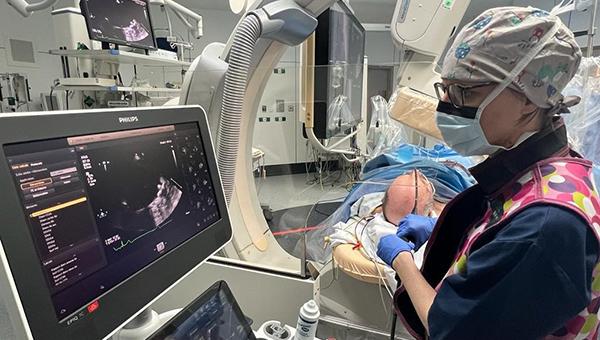Miniaturized TEE Probes Safe, Feasible for LAAO Guidance
Preplanning with a 3D imaging modality is key, but these smaller probes are likely sufficient for during the procedure, experts say.

Photo Credit: Adel Aminian
Miniaturized transesophageal echocardiography (TEE) probes designed for pediatric use appear to be a viable option for guiding left atrial appendage occlusion (LAAO) in patients with atrial fibrillation, allowing for use of conscious sedation and streamlining of procedures, indicates the largest multicenter experience published to date.
Among 546 patients treated across five European centers experienced in LAAO, there were high rates of technical and procedural success (98% and 97%, respectively), with few patients having major periprocedural complications (2.9%), according to researchers led by Adel Aminian, MD (Centre Hospitalier Universitaire de Charleroi, Belgium).
Only four patients (0.7%) needed to be converted from conscious sedation to general anesthesia due to poor image quality, they report in a paper published in the August 14, 2023, issue of JACC: Cardiovascular Interventions.
“We proved that this is really a safe way to perform a minimally invasive imaging approach for left atrial appendage occlusion. It’s the first time that we showed that within a multicenter registry,” Aminian told TCTMD, adding that preplanning and device sizing using some type of 3D imaging—either CT or TEE—is required for the best results.
In addition, use of mini or micro TEE probes for guidance during the procedure should be tried only in centers with mature LAAO programs, since the quality of the images is not as good as those obtained with standard TEE, Aminian advised. “I would not recommend this approach at the early stage of an experience when you still need to have optimal imaging during the case.”
Streamlining LAAO
LAAO has emerged as an alternative method for preventing stroke in patients with atrial fibrillation who are not good candidates for chronic oral anticoagulation for whatever reason. It will be increasingly used in the future, and there’s a need to simplify the procedure to increase efficiency and improve workflow, Aminian said.
Echocardiography is needed during LAAO to guide the transseptal puncture, optimize device placement, and monitor for potential complications, and standard TEE probes have been used for the vast majority of cases up to this point. The downside of this approach is the large size of the probes, which leads to the need for general anesthesia—and its potential complications—to ensure patient comfort.
In recent years, researchers have explored less-invasive options, like intracardiac echocardiography (ICE), that allow procedures to be done under conscious sedation. Miniaturized TEE probes may allow for similar advantages, although there are limited published data on this approach.
In the current study, Aminian et al retrospectively analyzed data on patients (mean age 76 years; 34% women) who underwent LAAO procedures that involved guidance from mini or micro TEE probes between November 2014 and April 2022. Most of the procedures (97%) were done under conscious sedation; in 12 patients, general anesthesia was planned as part of the learning curve for the use of micro TEE and in four, there was a conversion from conscious sedation to general anesthesia.
The primary efficacy endpoint was technical success, defined as having the device implanted in the correct position without a peridevice leak larger than 5 mm—this was accomplished in all but 12 patients. The secondary efficacy endpoint was procedural success, a combination of technical success and freedom from major periprocedural complications, and this was achieved in all but 18 patients.
This is really a safe way to perform a minimally invasive imaging approach for left atrial appendage occlusion. Adel Aminian
Both technical and procedural success rates were higher among patients in whom a preprocedural assessment for device sizing was performed using 3D imaging than among those in which sizing was performed during the procedure using the 2D images provided by the miniaturized TEE probes (P < 0.001 for both).
Major periprocedural complications (within 7 days of the procedure or before discharge) occurred in 2.9%, and these included cardiac tamponade in 1.6%, major bleeding in 1.0%, and TIA in 0.2%. Two patients (0.4%) died, one related to severe procedural tamponade due to atrial perforation and one related to type 2 ACS in the context of recurrent and severe GI bleeding.
Imaging follow-up was available at a median of 64 days in about three-quarters of the patients. The investigators detected large residual peridevice leaks on TEE in just two patients (0.7%) and device-related thrombus (DRT) on TEE, CT, or both in 5%. There were no strokes or embolic events observed at the time of DRT detection.
On cardiac CT, complete occlusion of the LAA was found in 82.2%. There were no cases of periprocedural device embolization.
Choice of Less-Invasive Modality
The researchers note that these results compare favorably to studies of ICE for procedural guidance, including one published earlier this year. One of the main drawbacks of ICE, however, is that most of these catheters can be used only once and may not be reimbursed, meaning that cost becomes an issue, Aminian said. Miniaturized TEE probes, on the other hand, can be used more than once.
Other potential limitations of ICE include a significant operator learning curve and the need for a second vascular access point, the investigators say.
On the flip side, TEE, even with smaller probes, requires the presence of an experienced echocardiographer and may induce esophageal injury.
For both ICE and mini/micro TEE, current technologies don’t offer 3D and biplane capabilities, although those shortcomings will be addressed with newer generations of devices moving through the pipeline.
Despite some differences between the options, “both imaging modalities are complementary, as they provide a safe and effective method to transition to mini-invasive imaging guidance for LAAO procedures,” Aminian et al write. “The choice of imaging modality will then depend on factors such as the patient’s preference, the physician’s experience and expertise, and the availability of equipment.”
And although miniaturized TEE probes may provide reduced image quality, “in our experience, micro- and mini-TEE provided sufficient image quality to achieve typical tasks required for LAAO guidance, including optimal transseptal puncture location, confirmation of adequate device positioning and stability, and monitoring of procedural complications,” the authors write.
‘Definitely Looks Promising’
Commenting for TCTMD, Sudarshan Balla, MD (West Virginia University, Morgantown), who wrote an accompanying editorial with Mohamad Alkhouli, MD (Mayo Clinic, Rochester, MN), estimated that currently in the US, 98% of LAAO procedures are performed with standard TEE guidance under general anesthesia, with a small number using ICE.
The high rates of success and low rates of complications observed with the smaller TEE probes and conscious sedation used in the current study are noteworthy, and the shift to this minimally invasive approach “also might lead to, hopefully, lower rates of esophageal injury,” Balla said. In addition, he said, this might improve turnover time in cath labs, although that remains to be proven.
One of the major obstacles to greater adoption of miniaturized TEE probes for LAAO guidance at the moment, Balla said, is the lack of 3D and biplane capability. That will change with newer devices, he said, “but the current generation of probes still have very poor image quality, so in some patients I think that might be an issue where you may have to end up taking the probe out and putting in a standard TEE probe.”
Additional validation of this minimally invasive approach, in the US and elsewhere, is needed as well, Balla said, pointing to the importance of studies with longer follow-up to monitor for potential complications and to assess effects on clinical outcomes, particularly with head-to-head comparisons with other imaging modalities.
But in the meantime, use of smaller TEE probes “definitely looks promising,” he said. “There is a potential to move that way. Especially with the newer-generation 3D probes that are coming out in the market, I think that move can be much more swift.”
Like Aminian, he stressed the importance of preprocedural 3D imaging to provide the best results. “It’s imperative that if someone were to adopt this currently, then the patient should already have the anatomy delineated on a good 3D modality a priori before the procedure and then [they can] go in with a pediatric probe at the time of the implant.”
Todd Neale is the Associate News Editor for TCTMD and a Senior Medical Journalist. He got his start in journalism at …
Read Full BioSources
Aminian A, Leduc N, Freixa X, et al. Left atrial appendage occlusion under miniaturized transesophageal echocardiographic guidance and conscious sedation: multicenter European experience. J Am Coll Cardiol Intv. 2023;16:1889-1898.
Balla S, Alkhouli M. Moore’s law and the quest for minimalist LAAO. J Am Coll Cardiol Intv. 2023;16:1899-1901.
Disclosures
- Aminian reports having served as a proctor and consultant for Abbott and Boston Scientific.
- Alkhouli reports being on advisory boards for Abbott, Boston Scientific, and Philips.
- Balla reports no relevant conflicts of interest.





Comments